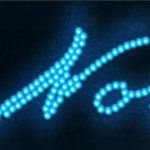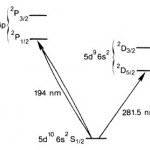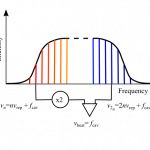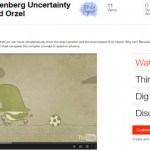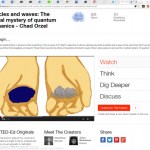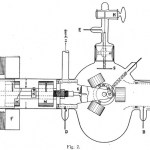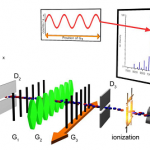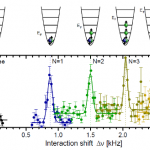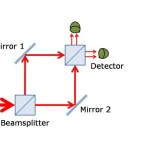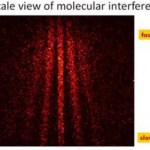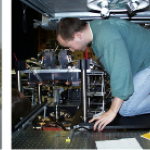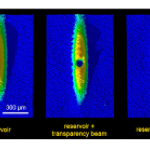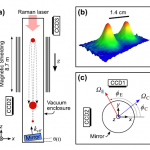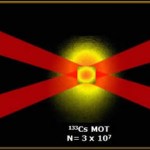Quantum Optics
The third of the videos I wrote for TED-Ed is now live: Schrödinger's Cat: A Thought Experiment in Quantum Mechanics.This is using basically the same argument I outlined in this post, but with awesome animation courtesy of Agota Vegso. I'm impressed by how close the images that ended up in the video are to the pictures I had in my mind while I was writing it.
As I said in that old post, I dithered for a bit about whether to run with this argument, but decided I liked it enough to go ahead. You can legitimately quibble about some of the phrasing being a little too definite (or that Schrödinger…
The 2014 Nobel Prize in Physics has been awarded to Isamu Akasaki, Hiroshi Amano and Shuji Nakamura for the development of blue LED's. As always, this is kind of fascinating to watch evolve in the social media sphere, because as a genuinely unexpected big science story, journalists don't have pre-written articles based on an early copy of a embargoed paper. Which means absolutely everybody starts out using almost the exact words of the official Nobel press release, because that fills space while they frantically research the subject. Later in the day, you'll get some different framing, once…
In a weird coincidence, shortly after I wrote a post about "quantum leap" as a metaphor, I was looking up some stuff about John Bell and ran into mentions of a paper he wrote called "Are There Quantum Jumps?" Bell is borrowing a title from Schrödinger, who wrote a pair of articles (really, one article in two pieces) for the British Journal for the Philosophy of Science in 1952 expressing his discontent with the entire idea of "quantum jumps" between states. Bell even opens his paper with a quote from Schrödinger: "If we have to go on with these damned quantum jumps, then I'm sorry that I ever…
On Twitter Sunday morning, the National Society of Black Physicsts account retweeted this:
Using Lasers to Lock Down #Exoplanet Hunting #Space
http://t.co/0TN4DDo7LF
— ✨The Solar System✨ (@The_SolarSystem) September 28, 2014
I recognized the title as a likely reference to the use of optical frequency combs as calibration sources for spectrometry, which is awesome stuff. Unfortunately, the story at that link is less awesome than awful. It goes on at some length about the astronomy, then dispenses with the physics in two short paragraphs of joking references to scare-quoted jargon from the…
The second one of the TED-Ed lessons I wrote about quantum physics has now been published: What Is the Heisenberg Uncertainty Principle. This is, again, very similar to stuff I've written before, specifically this old blog post and the relevant chapter of How to Teach [Quantum] Physics to Your Dog.
As usual, I tried but probably failed to do justice to other interpretations in the "Dig Deeper" references I sent; outraged Bohmians should feel free to comment either here or there with better explanations.
Again, it's really fun to see the images the animators found to put to my words. I love…
My TED@NYC adventure last fall didn't turn into an invite to the big TED meeting, but it did lead to a cool opportunity that is another of the very cool developments I've been teasing for a while now: I've written some scripts for lessons to be posted with TED-Ed. The first of these, on particle-wave duality just went live today.
The content here is very similar to my talk last fall, which is, in turn, very similar to Chapter 8 of Eureka: a historical survey of the development of quantum physics. I did the script for this, which was then turned over to professional animators, who did a great…
I didn't write a summary of the third day of "Quantum Boot Camp" to go with my Day One and Day Two summaries for a simple reason: I would've needed to do that on Saturday, and I spent Saturday in transit back to the US. More than that, though, it was harder to summarize than the other two days, because my talk was the middle of three, and thus I spent most of the first talk fiddling with my slides and fretting, and most of the third fighting off the post-talk adrenaline crash.
Happily, Sedeer at Inspiring Science offers a summary of the first two talks, namely Larus Thorlacius from Nordita…
The second day of the "Quantum Boot Camp" was much lighter on talks. The only speaker was Ray Laflamme from the Institute for Quantum Computing in Waterloo, who gave a nice introduction to quantum technologies. While he did spend a bit of time at the start going through Shor's algorithm for factoring numbers (following up a discussion from Wednesday), he mostly focused on ways to use quantum physics to improve sensors of technological interest.
So, for example, he talked about how efforts to develop techniques for error-correcting codes in liquid state NMR quantum computing led to the…
Since this part of the trip is actually work-like, I might as well dust off the blog and post some actual physics content. Not coincidentally, this also provides a way to put off fretting about my talk tomorrow...
I'm at the Nordita Workshop for Science Writers on quantum theory, which a couple of the attending writers have referred to online as boot camp, though in an affectionate way. The idea is to provide a short crash course on cool quantum physics, so as to give writers a bit more background in subjects they might need to cover.
The first talk was from Rainer Kaltenbaek (whose name I…
A couple of weeks ago, io9 ran a piece about the old accusations that Robert Millikan manipulated his data for the electron charge with the headlineDid a Case of Scientific Misconduct Win the Nobel Prize for Physics? that got a lot of attention. I wasn't as impressed with this as a lot of other people, mostly because it's mostly just adding a clickbait headline to a story that's been around for decades, and doesn't even really engage with the various responses and defenses of Millikan, including this PDF that offers a (to my mind) fairly convincing argument that most of the argument turns on…
Topping the looooong list of things I would give a full ResearchBlogging write-up if I had time is this new paper on a ultra-cold atom realization of "Dirac Monopoles". This is really cool stuff, but there are a lot of intricacies that I don't fully understand, so writing it up isn't a simple matter.
The really short version, though, is that a team of AMO physicists have created particles that are analogous to magnetic monopoles-- that is, to a particle that was only a "north" or "south" pole of a magnet, not both together like a conventional bar magnet (leading to my favorite social-media…
I'm teaching Quantum Optics this term, and one of my students picked "Atom Optics" off the list of suggested paper topics. When he asked for pointers, I said "You should check out the diffraction stuff Markus Arndt's group does." And just like that, a paper from the Arndt group turns up from the Arxiv Blog...
This is apparently only recently posted to the arxiv, though the article in Physical Chemistry Chemical Physics claims to have been online since July. Since I never get tired of talking about this, let's talk about this one, too.
So, what's this one about, then? In a lot of ways, it's…
Two papers with a similar theme crossed my social media feeds in the last couple of days. You might think this is just a weird coincidence, but I'm choosing to take it as a sign to write about them for the blog.
So, what are these papers, and what's the theme? One is the final publication of some results I saw at DAMOP and alluded to back in June, and the other is from this post by Doug Natelson. Both look at the transition from few-body to many-body physics.
And this is interesting, why? I mean, isn't it obvious that you just add some more bodies? OK, I guess that does need a little more…
When I posted congratulating the winner of this year's Nobel betting pool, I received a gentle reminder in email that I'm a Bad Person and still haven't done one of the posts I owe to the 2011 winners. Evan reminded me that he asked for something about the delayed-choice quantum eraser, so let's talk about that a bit, in the traditional Q&A format.
So, what's a delayed choice quantum eraser do? It may or may not have rubbed out mistakes you made while writing, but you don't know until later when somebody else chooses to read it? Nothing physical gets erased. The delayed-choice quantum…
Through some kind of weird synchronicity, the title question came up twice yesterday, once in a comment to my TED@NYC talk post, and the second time on Twitter, in a conversation with a person whose account is protected, thus rendering it un-link-able. Trust me.
The question is one of those things that you don't necessarily think about right off-- of course an atom is a particle!-- but once it gets brought up, you realize it's a little subtle. Because, after all, while electrons and photons are fundamental particles, with no internal structure, atoms are made of smaller things. But somehow we…
Element: Cesium (Cs)
Atomic Number: 55
Mass: One stable isotope, mass 133 amu.
Laser cooling wavelength: 854nm, but see below.
Doppler cooling limit: 125 μK.
Chemical classification: Yet another alkali metal, column I of the periodic table.
This one isn't greyish, though! It's kind of gold color. Still explodes violently in water, though.
Other properties of interest: The definition of the second in the SI system of units is in terms of the microwave transition between hyperfine ground states in Cs-- 9,192,631,770 oscillations to one second, to be precise. Has a really large scattering…
Element: Strontium (Sr)
Atomic Number: 38
Mass: Four stable isotopes, ranging from 84 to 88 amu
Laser cooling wavelength: Two different transitions are used in the laser cooling of strontium: a blue line at 461 nm that's an ordinary sort of transition, and an exceptionally narrow "intercombination" line at 689 nm.
Doppler cooling limit: 770 μK for the blue transition, below a microkelvin for the red. The Doppler limit for the red line turns out not to be all that relevant, as other factors significantly alter the cooling process.
Chemical classification: Alkaline earth, column II of the…
When I wrote up the giant interferometer experiment at Stanford, I noted that they've managed to create a situation where the wavefunction of the atoms passing through their interferometer contains two peaks separated by almost a centimeter and a half. This isn't two clouds of atoms each definitely in a particular position, mind, this is a wavefunction representing a bunch of atoms that are each partly in two places at the same time , separated by 1.4 centimeters.
I emailed Mark a link to the post, and in his reply he said that they've increased that to about 4cm (which is just a matter of…
A little over a year ago, I visited Mark Kasevich's labs at Stanford, and wrote up a paper proposing to use a 10-m atom interferometer to test general relativity. Now, that sounds crazy, but I saw the actual tower when I visited, so it wasn't complete nonsense. And this week, they have a new paper with experimental results, that's free to read via this Physics Focus article. Which might seem to make me blogging it redundant, but I think it's cool enough that I can't resist.
OK, dude, "Multiaxis Inertial Sensing with Long-Time Point Source Atom Interferometry" is not the sexiest title in the…
The last post in this series on the core technologies of cold-atom physics dealt with optical molasses, where you use the scattering of light to exert forces on atoms to make them very, very cold. It turns out, they end up even colder than the simple theory would lead you to expect, which is very surprising, but also essential to the revolutionary impact of cold atom physics. If you were stuck with the Doppler cooling limit temperatures, laser cooling probably wouldn't be as big a deal as it is now.
You can do better, though, thanks to the interaction of several bits of physics that go beyond…

